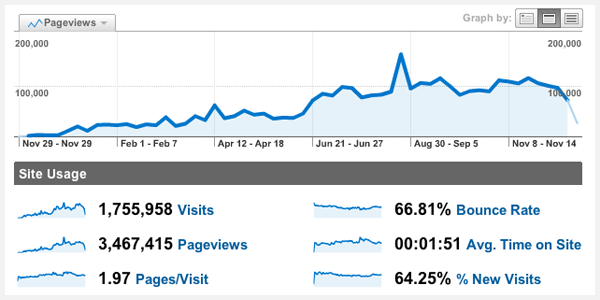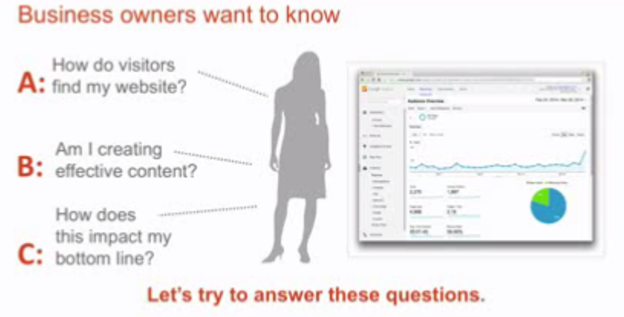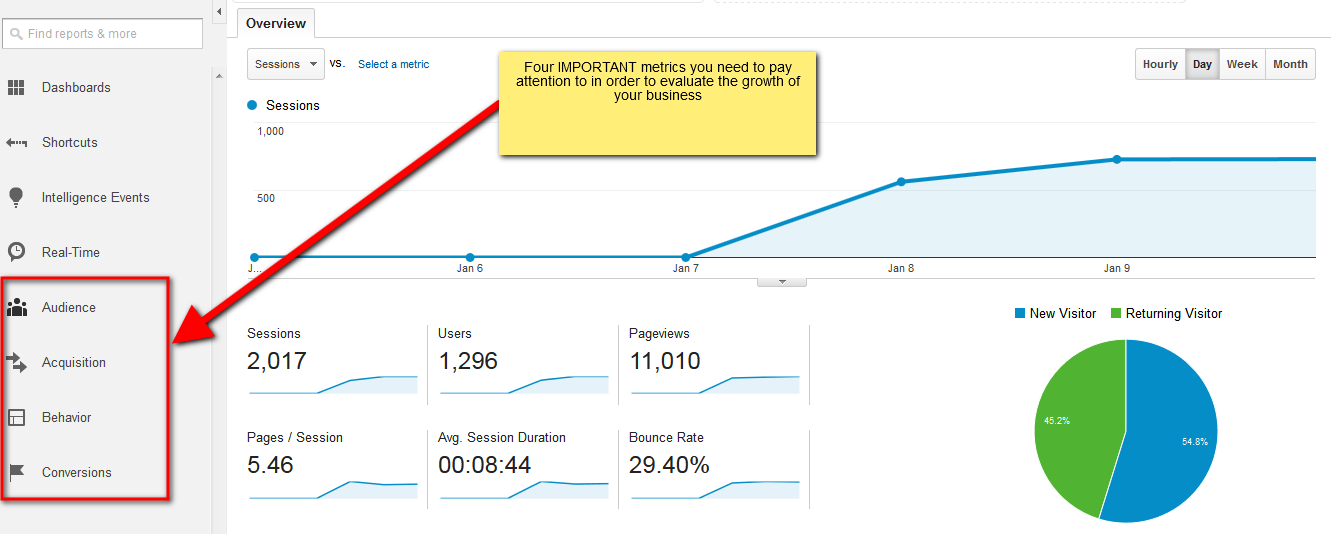We all love to brag.
Startup founders love to brag about big growth numbers; like the numbers of their registered users, app downloads, and raw page views.
They will even publish them for bragging rights while happily linking to Alexa and QuantCast as proofs that they are doing well.
Everybody does that. Reddit, Jobberman, IrokoTV… And the list goes on.
 A typical Google Analytics page view
A typical Google Analytics page view
Does this mean they are doing well?
This is not true.
This metric, most of the time does not necessarily correlate to the numbers that really matter or show the true health of your business. They are vanity metrics and could be dangerous for your business.
Why would I say so?
Quoting Eric Reiss, “The only metrics that entrepreneurs should invest energy in collecting are those that help them make decisions. Unfortunately, the majority of data available in off-the-shelf analytics packages are what I call Vanity Metrics. They might make you feel good, but they don’t offer clear guidance for what to do.”
So if you are building a success-bound venture, your goal is to look at your business growth differently by setting specific targets to measure the growth and improve the performance of your start-up.
I am convinced that there is a better way to look this. In fact, I wrote a long and critical piece on growth and how to make it happen. (Caveat: it is a LONG post with useful business insights revealing how I helped a startup grow to their first 10,000 customers in 3 months).
How Do You Decide What to Measure in Your Startup?
So how do you decide what to measure?
When deciding what to measure, you want to focus on quantifiable factors that are clearly linked to the drivers of success in your business.
In the online world, there are five common business objectives:
- If you run an ecommerce sites, an obvious objective is selling products or services. This article breaks down 8 of the key ecommerce objectives you should track
- For a lead generation site, the goal is to collect user information for your sales teams to connect with potential leads
- For content publishers, like blogs, the goal is to encourage engagement and frequent visitation
- For online informational or support sites, helping users find the information they need at the right time is of primary importance
- And finally for branding, the main objective is to drive awareness, engagement and loyalty
One person that does this right is Jason Njoku of IrokoTV. On his blog, his analyses of revenue per customer here, here and here are solid fundamentals to measure in your business.
| BONUS: At the end of this post, I included a list of top 10 tools that big startups like Jumia, IrokoTV and Konga use to analyze the performance of their websites PLUS The secret tool you can use to reveal the technology of your competitor’s site ((without holding anything back) so that you can copy them. You can access it here, FREE. |
Let us look at a typical example……
I will create an example that will assist you understand this concept of how to set useful targets for your website.
STEP 1: Document your business objective(s)
The first step is to start with objectives because a good measurement plan starts with you documenting your business expectations.
In this document, you ask yourselves soul searching questions like: why do we exist? What are our ultimate goals?
Often you need to dig really deep to get the true answer. For example, the business objective of TechCabal is : “…… about getting the smartest guys in the space into one “room”, and then getting the hell out of the way so that the rest of the ecosystem can actually learn something…”
Good.
That means that primarily, the objective is in getting the best guys to write blog post on TechCabal and also, to build a community of people to comment on posts and engage on social media based on discussions that start off on this blog.
(Don’t forget that this is all fictional……… I want you to relate this example to your own project: a blog, an app or website).
STEP 2: Decide on the strategies and tactics to achieve your objective(s) above
The next step is to break down your objectives into strategies and tactics. This makes it easy to develop a system.
Using the TechCabal example above, an effective strategy could be to have a minimum of 30 high-profile columnist across venture capitalists, startup founders and developers. This variety is expected to provide informative posts that cut across the needs of the website audience.
(NOTE: You can have multiple strategies that cut across each of your objectives)
Based on the first strategy, the tactic that delivered on this single strategy above will include:
- Gets new and old authors to publish their best stuffs for TechCabal
- Develop and manage an editorial calendar system for the columnists and an appropriate incentive to keep them writing
STEP 3: Thirdly, track your traffic channel
Traffic is the blood of your business.
And you want traffic ready to convert to repeat visitors and paying customers.
In our TechCabal example, we’re going to track all traffic channels to see what contributed to revenues, blog engagements (comments) and the social media reach of the blog.
So the basis of the analysis will look like this:
- What channels brings the most visitors to the site: Email (newsletter subscribers), twitter or LinkedIn?
- Based on blog comments, which type of blog post/editorials engages our users the most?
- Which of the authors contribute most significantly to website traffic?
- Are our reposts on LinkedIn Pulse doing better that twitter updates?
- Are the comments showing new opportunities for blog posts we should be focusing on for growth?
The traffic channels you choose can be the same or different across all of your website objectives; it all depends on what your business is doing and which strategies and tactics are being used to reach your objectives.
Finally, let’s set a target for a single traffic channel…….. Email sign ups.
Email sign ups.
If you have noticed, you see that the real TechCabal website has an email sign up page:

A typical target can be to grow the newsletter sign up rate. For example, TechCabal can set a target to measure the conversion of website visitors that sign up for the newsletter.
If this is currently low, a strategy can be designed to increase the sign up rates (This means that a revenue opportunity has just been met).
The more specific the target is, the easier it is to measure and optimize the goal performance.
TOOLS YOU CAN USE TO MEASURE ACTIONABLE METRICS
So what is the best tool to do this?
There are several good options I can recommend for you; both free and premium. However, it is important to understand that metrics for metric’s sake are not very useful.
The truth is there are many useful tools to do this.
But for starters, let’s look at one of the most useful…….. And a FREE option.
It is called Google Analytics.
Google analytics dashboard has four major categories that assist you to build your audience based on data that assist you to serve your current customers and win new ones.
They are Audience, Acquisition, Behaviour and Conversion overviews.
Take a plunge at it to get a head-start and start measuring your website or app performance. You can learn free at Google Analytics University
So here we are……
- I have shown you that vanity metrics is dangerous for your business
- We have seen how you can set up an actionable measurement for your startup
- You have also discovered how useful Google Analytics is as a good and free tool you can use to achieve this with your start-up
The truth is that when you understand the metrics that impact your business, you will make right decisions on your advertising budget, staffing and business priorities.
Business should be about success stories when the right things are measured.
Wole Ogunlade is a digital marketing expert; he is the editor of SpokenTwice.com, a blog dedicated to teaching marketing topics covering conversion optimization, growth hacking and marketing automation strategies that are guaranteed to help technology startups and small business increase customers’ growth and sales.
Photo Credit: Lucas Hayas via Compfight cc













